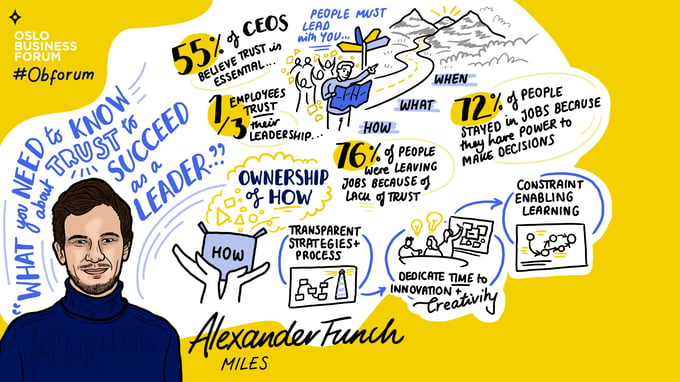Alexander Istad Funch is a senior consultant and agile coach with Miles AS, a unique IT company providing consulting and advisory services. The organization is uniquely focused on creating great workplaces.
At Oslo Business Forum, Alexander explained what leaders need to know about building trust to mitigate threats to their businesses today.
The biggest threat to business
In the environment we’re working in today, we face many threats. Leaders are navigating risks—both internal and external—that have the potential to deeply impact their success and the success of their business. But the number one threat that leaders perceive may surprise you.
According to recent research, 55% of CEOs believe that a lack of trust is the biggest threat to their business—and that same research cites that only one in three employees trust their employer.
“Why is leading through trust so important today, yet so hard?” asked Alexander. Two trends are driving the need for trust in business:
- Customers expect more. Accelerating customer expectations mean leaders must adapt to change and respond to customer needs faster.
- Employees expect more. Rising employee expectations mean leaders must create a trust-based culture that attracts and retains the best talent.
Top-down vs. trust-based leadership
At its core, leadership is about generating the best possible outcome by pointing a team toward a goal. But there are many ways to guide your team in its mission. Alexander demonstrated the difference between top-down and trust-based leadership.
A traditional “mission command” approach to leadership is about giving and receiving orders, commanding how the team reaches its end goal.
A trust-based approach to leadership is about telling why and what but never how. The most effective leaders inspire trust in their teams by staying focused on their vision and allowing freedom in how the team gets there.
"Trust as a leader is about telling why and what but never how."
When employees work for a leader who inspires trust, they are more likely to take ownership of the mission. They are more likely to adapt to change and increase their resilience.
The biggest challenge for modern leaders
“For modern companies,” said Alexander, “The biggest challenges are the rate of change and adaptability.”
Emerging technology, increased consumer expectations, and new ways of working are all trends creating change and forcing adaptability today. And with these trends, attracting and retaining top talent becomes more difficult.
Alexander believes the answer to these challenges is for leaders to be less controlling and create greater trust. Research has shown that:
- 76% of people whose leaders didn’t have confidence in them to act independently were looking for new jobs.
- 72% of people who could act and make decisions on their own said they were satisfied in their jobs.
This demonstrates that factors other than salary are important to employee retention. Survey respondents cited factors such as freedom, the ability to be creative, and having room for innovation as critical to their satisfaction—all of which are based on trust.
A trusting culture creates a more productive, attractive, and better place to work. Research also demonstrates that people who work in high-trust companies experience:
- 75% less stress
- 50% higher productivity
- 76% more engagement
Three steps to build greater trust
So, how can we create these outcomes for our own teams? Alexander offered leaders at Oslo Business Forum three things to do today to build greater trust tomorrow:
- Be clear about WHAT. Leaders must make their vision and strategy transparent for everyone, both on the team and the organizational level. They must ask themselves, “Is there a clear connection between desired outcomes (our vision) and day-to-day tasks?”
- Dedicate time to creativity and innovation. Leaders must reserve time for their teams to be creative and ensure they are not overflowed with day-to-day tasks. They must ask themselves, “Do people have the time and space to think about new solutions and new ideas?”
- Guide in the right direction. Leaders must master the art of constraint-enabling learning, which encourages creativity and autonomy within established guidelines. They must remember that this is not about giving free reign but rather ask themselves, “Have I facilitated where and what, so the team can solve how?”
To summarize, Alexander emphasized that to be a future-focused leader, you must build a trust-based culture. Addressing the perceived lack of trust in organizations today starts with small steps: creating transparency, encouraging creativity, and providing guidance.
Key Points
- Being a future-focused leader requires creating a trust-based culture.
- A trust-based culture enables leaders to keep pace with accelerating customer and employee expectations. It creates greater adaptability and helps organizations attract and retain the best talent.
- 55% of CEOs believe that lack of trust is the biggest threat to their business today, and only one in three employees trust their employer.
- To solve these challenges, leaders must create transparency, encourage creativity, and provide guidance.
Questions to Consider
- Is there a sense of trust on my team today? Is there trust across our organization?
- Is there a clear connection between our vision and employees’ day-to-day tasks?
- Do employees have the time and space to be creative and innovative?
- Have I provided direction by facilitating where and what, so the team can solve how?

Want to be a part of the OBF community? Join Oslo Business Forum 2023: Thriving in Chaos now!.png?width=680&name=CTA_2023%20(2).png)